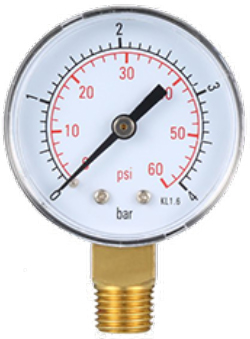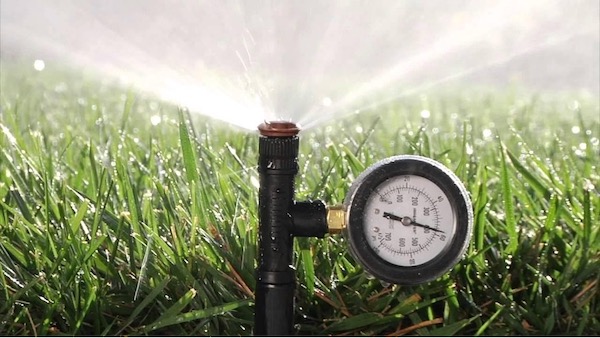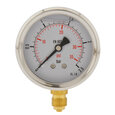Water Pressure Gauge - How it Works

Figure 1: Water pressure gauge
A water pressure gauge is a measurement instrument that indicates the water pressure in a system. It is a calibrated pressure indicator that is connected to a water pipe or tank, and converts the force exerted on it into units such as Pascal, bar, psi, and Torr. Water pressure gauges provide real-time pressure measurements in domestic, commercial, and industrial applications. They are easy to use, durable, and require little maintenance. Read our pressure gauges overview article to learn more about how they work.
Table of contents
Tamesons selection of bourdon pressure gauges
Water pressure
A system's water pressure can be static or dynamic. Static pressure is the pressure of water when it is not moving. Conversely, dynamic pressure is the pressure of flowing water. There are several reasons why it is essential to know both static and dynamic water pressures in a plumbing system.
Static pressure
- Design: Knowing the static water pressure can help ensure that the plumbing system's design can handle the pressure of supply water. If the pressure is too high, it can cause damage to fixtures and pipes. At the same time, if the pressure is too low, getting enough water flow to certain areas of the system can be challenging.
- Diagnostics: If experiencing low water pressure, knowing the static pressure can help determine whether the problem is with the main water supply or somewhere in the plumbing system.
- Safety: High static water pressure can cause pipe bursts or leaks, leading to flooding and water damage. If the pressure is too high, a possible solution is to install a pressure-reducing valve (PRV).
- Efficiency: Low static pressure means low flow, which means less efficient use of appliances that use water, like washing machines and dishwashers.
- Comfort: High static pressure can make showerheads, faucets, and other fixtures feel too powerful, uncomfortable, and hard to control.
Dynamic pressure
- Flow: Dynamic water pressure determines the flow rate through the system. Knowing dynamic water pressure can ensure that the plumbing system can handle the anticipated demand for water in the home or building.
- Pressure loss: Knowing dynamic water pressure helps calculate the system's pressure loss due to friction, valves, and other fittings. This helps to understand the system's performance and identify areas needing improvement.
- Efficiency: The dynamic pressure can be used to ensure the appliances and fixtures in the system are working efficiently, as they need a certain pressure to operate properly.
- Safety: High dynamic pressure can cause pipe bursts or leaks, and low pressure can cause appliances not to work properly or less efficiently. Pressure-boosting pumps could be installed if the pressure is too low.
Bourdon tube operation
While multiple types of pressure gauges are available for measuring water pressure, the most common is the bourdon tube pressure gauge. Inside a bourdon tube pressure gauge is a curved tube with an oval cross-section. Water flows into one end of the tube, and the pressure from the water causes the tube to begin straightening. The gauge's indicator moves in proportion to the amount of tube straightening, displaying the pressure in the system. Learn more specifics about a bourdon tube pressure gauge's operation by reading our bourdon tube overview article. To investigate other types of gauges for measuring water pressure, read our articles on bellows, diaphragm, liquid filled, and digital pressure gauges.
Water pressure gauge applications
Industry
Various industries use pressure gauges for water to measure the pressure of water in pipes, tanks, and other vessels. Water pressure gauges help monitor the flow and pressure of water to ensure that the system operates within safe and efficient parameters. These gauges are applicable in various settings such as power plants, manufacturing facilities, and buildings to measure the water pressure for different systems such as cooling, heating, or process water. In case of any anomalies, the pressure gauge is a diagnostic tool to identify the problem area in the system. The following are examples of where to install water pressure gauges in a power plant:
- Boilers: For power plants that use boilers, install a water pressure gauge at the inlet and outlet of each boiler to monitor the pressure feedwater and steam, respectively.
- Cooling towers: Similar to boilers, install water pressure gauges at the inlet and outlet of cooling towers to monitor the pressure of the circulating water.
- Pumps: Install water pressure gauges at the discharge of pumps to monitor the water pressure and flow rate coming from the pumps.
- Pressure drop points: Install a water pressure gauge after any point in the system that produces a significant pressure drop, such as after a filtration unit. This will help monitor the pressure drop to ensure it does not exceed acceptable parameters.
Residential and commercial
In residential and commercial plumbing systems, install a water pressure gauge near the main water shutoff valve, which is typically near the point where the water supply enters the building. This will allow the monitoring of the incoming water pressure to ensure it's within a safe range.
In addition, install a pressure gauge on the discharge side of a pressure-reducing valve if the system has one. A pressure gauge at the PRV's outlet will indicate whether the PRV is functioning properly and if the pressure at the building’s outlets (e.g., sinks and showers) are safe.
Other common applications for water pressure gauges are:
- Pool filter pressure gauge: A pool filter pressure gauge helps keep track of the pressure variations within a pool system. After a baseline pressure reading, high pressure typically indicates the filter needs cleaning, and low pressure indicates a flow issue. Learn more about pool filter pressure gauges.
- Irrigation and sprinkler system: Water pressure gauges are used to indicate the pressure in an irrigation network for a farm or a sprinkler system in a garden.
- Leak detection: Water pressure gauges are installed in closed water loops, such as a heating circuit or a process line, to indicate a leak in the circuit.
- Measuring tank volume with pressure: A pressure gauge can help track the water volume in an open vertical tank or column of water. Changes in the pressure will indicate discharge or refill of water from or to the tank.
- Well pressure: Buildings with well water use well water pressure gauges to know when there is low well pressure. For example, a pressure gauge on well pump monitors the water pressure at the pump’s discharge. This helps planning for maintenance, using other sources of water, or drilling another well.
With all applications, pressure gauges are subject to the usual wear and tear. Read our article on the maintenance and troubleshooting of pressure gauges for more details on troubleshooting pressure gauges.
Note: Depending on the specific design and layout of the plumbing system, additional pressure gauges may be necessary at other locations to provide a comprehensive view of the system's pressure.

Figure 2: A pressure gauge for a sprinkler system
Selection criteria
When selecting a water pressure gauge for a residential, commercial or industrial application, there are several factors to consider:
- Pressure range: A pressure gauge for water should be rated for the maximum pressure that will be encountered in the system.
- Accuracy: The gauge should have an accuracy that meets the requirements of the application. Typically, a gauge with a 2-3% full-scale accuracy is acceptable for most applications.
- Size and visibility: The gauge should be of a suitable size for the installation location, and the dial should be large enough to be easily read by the operator.
- Mounting options: The gauge should have a compatible mounting option for the installation location.
- Materials: The gauge and its internal components should be made of materials that are resistant to corrosion, abrasion, and other factors that are typical of the process. Read our material resistance guide to learn more.
- Environmental considerations: The gauge should be able to withstand the temperature and humidity conditions present in the location of installation.
-
Certification: If the application is in an industry with specific regulations, it is important to choose a gauge that meets the relevant certifications and standards. Certifications and standards vary by application and location, and are also subject to change. However, some common standards currently are:
- ASME B40.100: This is the standard for pressure gauges used in the United States, which sets guidelines for the design, construction, and performance of pressure gauges.
- EN 837-1: This is the European standard for pressure gauges, which sets guidelines for the design, construction, and performance of pressure gauges.
- CE Marking: This is a certification that indicates that a product meets the requirements of European Union health, safety, and environmental protection legislation.
- NEMA standards: This standard is developed by the National Electrical Manufacturers Association, it's a standard for the design, construction and testing of electric gauges.
- ATEX: This is a European Union directive that covers equipment and protective systems intended for use in potentially explosive atmospheres.
- IECEx: is a global certification scheme for equipment used in explosive atmospheres.
- Electric or mechanical: Digital water pressure gauges have more features like remote reading, data logging and electronic display; whereas mechanical gauges are more durable, easy to maintain and can handle extreme conditions.
Read our selection tips for pressure gauges to learn more about how to select a pressure gauge.







